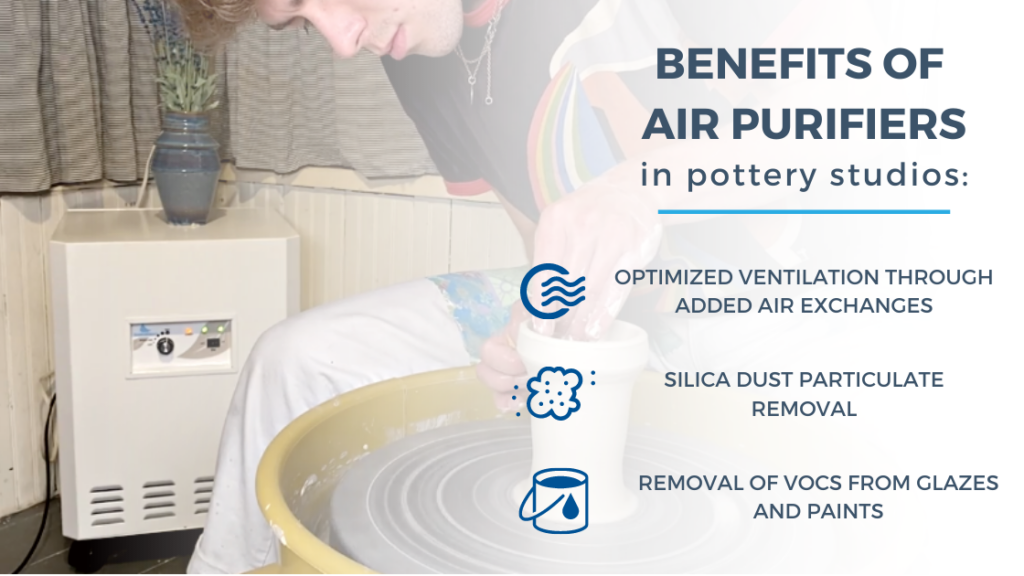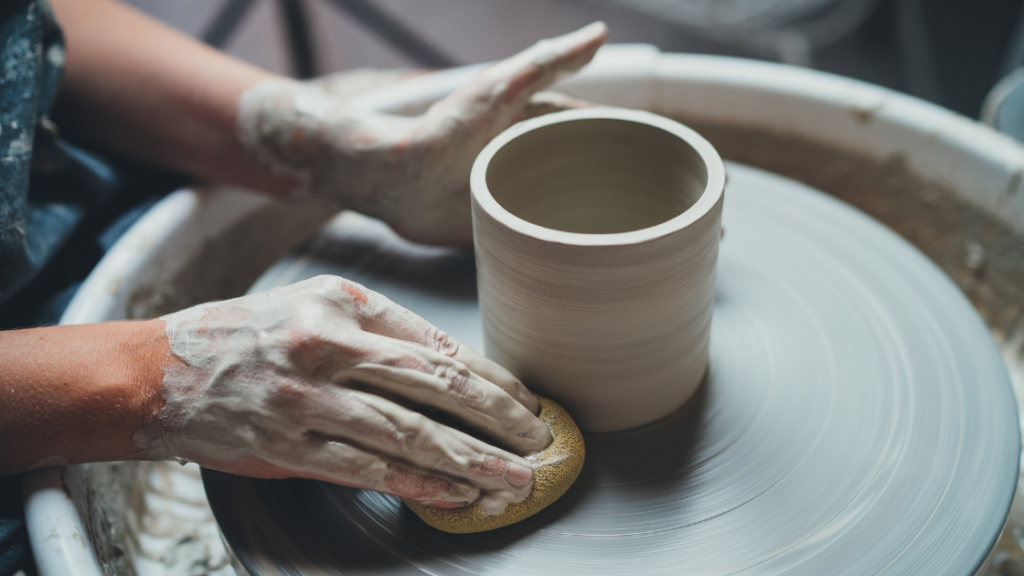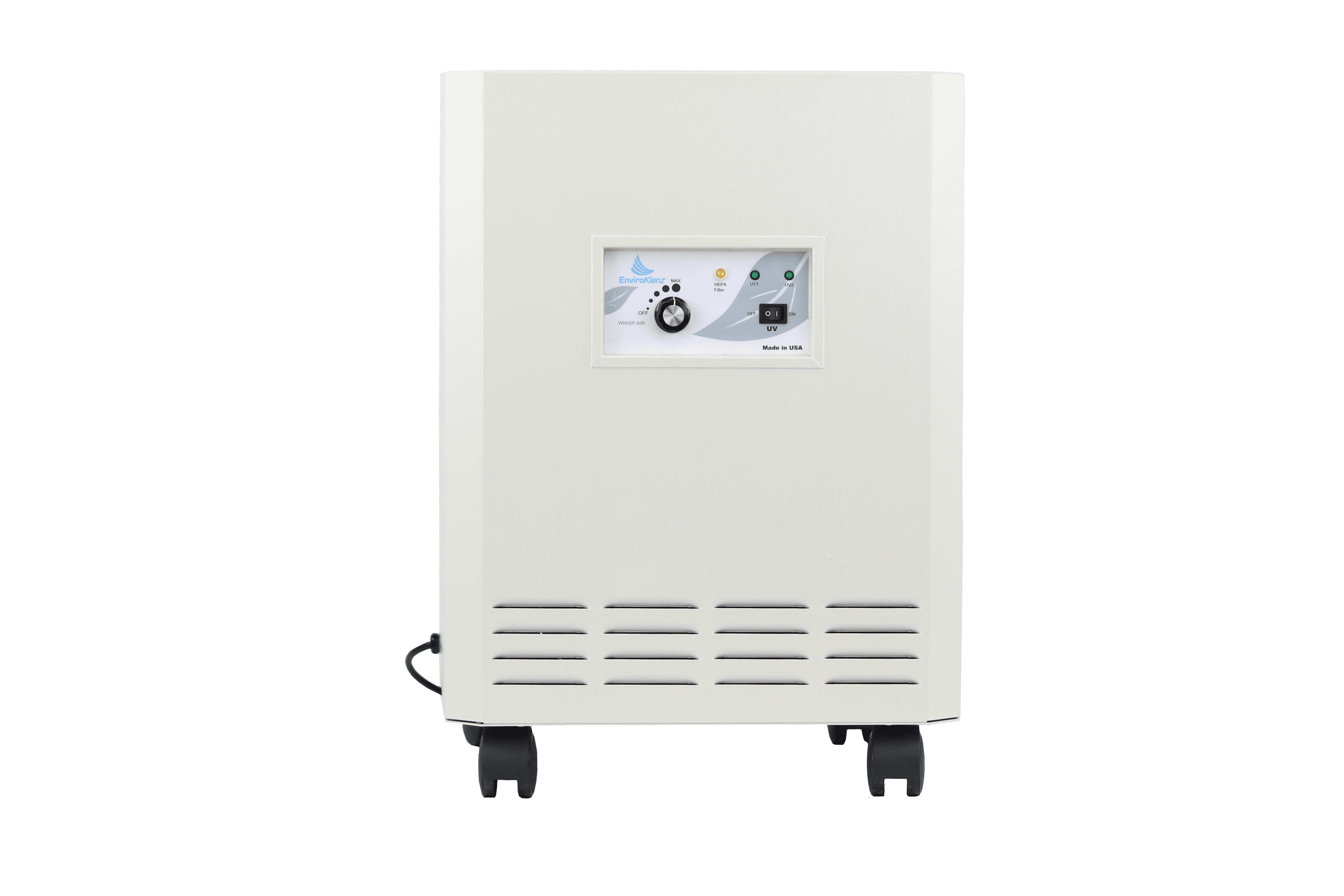Working with clay in the comforts of your home pottery studio can be an enjoyable and rewarding pastime for aspiring and veteran potters alike. But if you’re just starting out, you may be wondering if it’s even safe to do pottery at home. From clay dust to hot kilns, it’s smart to be cautious and to set up your home pottery studio with safety in mind.
We’ve got a few helpful ways to keep your home pottery studio safe, covering ventilation standards and cleaning practices that are clay dust-proof (well…as close as you can get!). Keep reading to learn more!
Is It Safe to Do Pottery at Home?
While there are some hidden dangers of working with clay, like developing a condition called silicosis (potter’s lung), the good news is that there are a few simple steps you can take to keep your home pottery studio safe from harm. Before jumping to the solutions, it’s important to dive into some of the potential risk factors of making pottery at home.
Whether you’re hand building or throwing clay, mixing glazes, or firing a kiln, potters need to educate themselves on the potential risk factors of each stage of the artistic process:
Clay used in pottery studios is typically composed of minerals such as hydrated aluminum silicates and other components like sand, grog, and talc. Sometimes other organic matter and impurities can show up in clay like manganese or crystalline silica.
The real harm occurs when the clay dries and these toxic ingredients are breathed in, which can cause health problems like silicosis if these toxins are inhaled over a long period of time. That’s why it’s important for potters to read the Material Safety Data Sheets (MSDS) to educate themselves on the ingredients before working with clay.
Due to Federal regulations, most ceramic glazes sold for personal or studio use are harmless, but some may still contain trace amounts of lead that can be leached into food or drink if not properly fired. Additionally, some glazes may contain metal oxides that are highly toxic if inhaled or come in contact with skin. Some can even emit harmful VOCs when fired in the kiln.
While some glazes contain toxins, most are safe when the proper safety precautions are put in place. Centuries ago it was common for glazes to contain lead, which caused hundreds of cases of lead poisoning. Thankfully, new techniques have largely replaced the need for lead in glazes, making the process much safer. Make sure to use lead-free glazes and steer clear of any glaze that doesn’t state “leadless” on the label.
Potters may use different types of kilns depending on the type of clay and glazes used. Most home pottery studios are set up with electric kilns due to their simple configuration and ease of use, while larger studios may have a fuel-fired kiln that’s heated by burning natural gasses.
Some clay bodies and glazes contain materials that become toxic when vaporized in the kiln. Breathing in these toxins can be incredibly harmful to your health, especially if the clay contains lead or certain metal oxides. Regardless of whether the kiln is electric or fuel-fired, pottery studios must have proper ventilation to ensure noxious fumes cannot be inhaled during the firing process.
Clay Health and Safety Rules
It’s been mentioned, but it’s worth repeating. Inhaling clay dust and chronic pottery silica exposure can cause irreversible health problems if the proper precautions are not taken. Clay is made up of minerals and other organic compounds, but most ceramic clay contains large amounts of silica. When clay dries, silica can become airborne and easily inhaled if not contained properly.
Continually breathing in silica dust found in clay can cause a condition known as silicosis or ‘potter’s lung’. This is where silica dust particles cling to lung tissue, causing an immune reaction. Over time, silicosis can result in irreversible lung damage and potentially lead to other diseases. You can learn more about the risks of pottery silica exposure by reading our article ‘What is Silicosis – Hidden Dangers of Working with Clay at Home’. Thankfully, there are a few simple steps you can take to keep your home pottery studio safe from airborne contaminants like dust and VOCs that come from working with clay .

How Do You Protect Yourself from Clay Dust?
Now that you know the risks, how do you protect yourself from inhaling too much clay dust? Ultimately, you want to reduce the amount of dust you may come in contact with in your home pottery studio. For starters, purchasing premixed clay can help you to avoid unnecessary exposure to large amounts of dry clay. You may also want to consider wearing a non-porous work apron and a mask when you are around clay dust. But the best way to protect yourself is to keep your studio clean and ensure your studio is equipped with proper ventilation.
Pottery Studio Ventilation
While cleaning is extremely important to keep dust levels low, proper ventilation is a home potter’s first line of defense. Whether you’re minimizing dust levels or purifying the air of harmful VOCs and toxins, proper air exchange is key for keeping your home pottery studio clean and safe. Opening windows can certainly bring fresh air in, but outside breezes can’t remove dust particles like an air purifier can.
For beginner home potters, you might assume you need a complicated built-in air filtration system to get the job done, but that can’t be farther from the truth. Portable, high-efficiency air purifiers for pottery studios, like the EnviroKlenz Air System, are able to grab airborne pollutants and capture them within filters, while supplying fresh air at quicker air exchange rates than HVAC systems or natural ventilation.
Place one of these air purifiers in your home pottery studio, and its patented earth-mineral technology will go to work. The combination of the EnviroKlenz Air Cartridge and HEPA filter is a double defense against airborne particulates, including dust and VOCs produced by pottery activities. It is worth the investment, as this consideration can make for a much healthier studio for any potter.

How Do I Keep My Pottery Studio Clean?
One of the easiest ways to keep your pottery studio clean is to mop floors and work surfaces daily. Wet vacs can also be used and can cut cleaning time, but if you use a dry vacuum, make sure it’s equipped with special filtration systems first. Because silica particles will enter the air, dry sweeping your pottery studio is not recommended.
While it may be tempting to leave a few clay scraps lying around your work area, dry clay scraps can easily be stepped on and pulverized into dust. That’s why it’s important to clean up your work space with a wet sponge as you go.
EnviroKlenz® Medical Disclaimer:
“Any information that is provided on this website is not for the use by any commercial or personal entity without expressed written consent of the blog author. The material and statements illustrated within this blog are not intended to diagnose, treat, cure, or prevent any diseases or medical conditions. Nor does the author in any way guarantee or validate the validity, totality, or efficacy of any claims and will therefore not be held responsible for the content of any claims. Always consult your medical physician for any specific medical advice or recommendations.”









